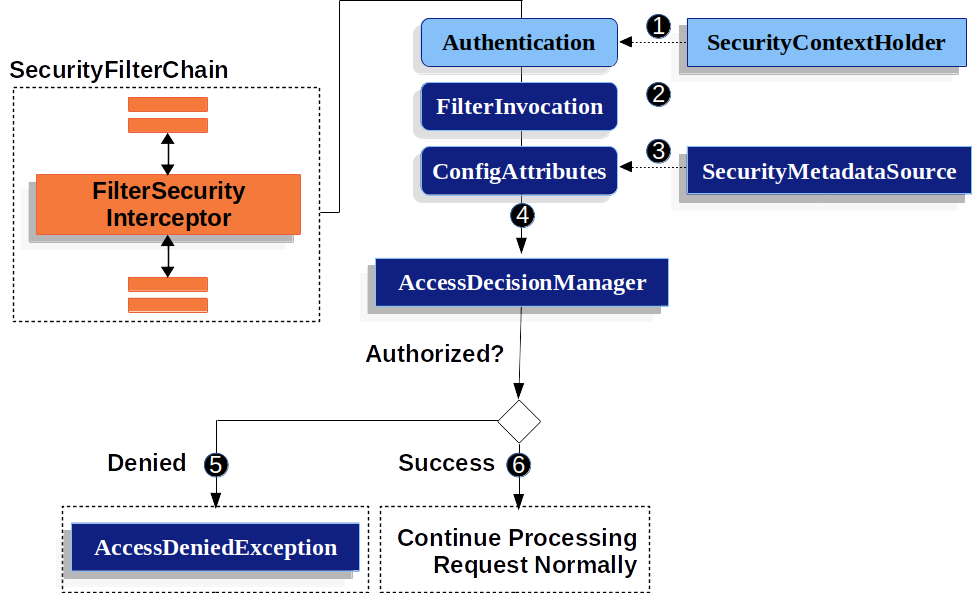Authorize HttpServletRequest with FilterSecurityInterceptor
This section builds on Servlet Architecture and Implementation by digging deeper into how authorization works within Servlet based applications.
The FilterSecurityInterceptor provides authorization for HttpServletRequests.
It is inserted into the FilterChainProxy as one of the Security Filters.

-
 First, the
First, the FilterSecurityInterceptorobtains an Authentication from the SecurityContextHolder. -
 Second,
Second, FilterSecurityInterceptorcreates aFilterInvocationfrom theHttpServletRequest,HttpServletResponse, andFilterChainthat are passed into theFilterSecurityInterceptor. -
 Next, it passes the
Next, it passes the FilterInvocationtoSecurityMetadataSourceto get theConfigAttributes. -
 Finally, it passes the
Finally, it passes the Authentication,FilterInvocation, andConfigAttributes to theAccessDecisionManager.-
 If authorization is denied, an
If authorization is denied, an AccessDeniedExceptionis thrown. In this case theExceptionTranslationFilterhandles theAccessDeniedException. -
 If access is granted,
If access is granted, FilterSecurityInterceptorcontinues with the FilterChain which allows the application to process normally.
-
By default, Spring Security’s authorization will require all requests to be authenticated. The explicit configuration looks like:
protected void configure(HttpSecurity http) throws Exception {
http
// ...
.authorizeRequests(authorize -> authorize
.anyRequest().authenticated()
);
}<http>
<!-- ... -->
<intercept-url pattern="/**" access="authenticated"/>
</http>fun configure(http: HttpSecurity) {
http {
// ...
authorizeRequests {
authorize(anyRequest, authenticated)
}
}
}We can configure Spring Security to have different rules by adding more rules in order of precedence.
protected void configure(HttpSecurity http) throws Exception {
http
// ...
.authorizeRequests(authorize -> authorize (1)
.mvcMatchers("/resources/**", "/signup", "/about").permitAll() (2)
.mvcMatchers("/admin/**").hasRole("ADMIN") (3)
.mvcMatchers("/db/**").access("hasRole('ADMIN') and hasRole('DBA')") (4)
.anyRequest().denyAll() (5)
);
}<http> (1)
<!-- ... -->
(2)
<intercept-url pattern="/resources/**" access="permitAll"/>
<intercept-url pattern="/signup" access="permitAll"/>
<intercept-url pattern="/about" access="permitAll"/>
<intercept-url pattern="/admin/**" access="hasRole('ADMIN')"/> (3)
<intercept-url pattern="/db/**" access="hasRole('ADMIN') and hasRole('DBA')"/> (4)
<intercept-url pattern="/**" access="denyAll"/> (5)
</http>fun configure(http: HttpSecurity) {
http {
authorizeRequests { (1)
authorize("/resources/**", permitAll) (2)
authorize("/signup", permitAll)
authorize("/about", permitAll)
authorize("/admin/**", hasRole("ADMIN")) (3)
authorize("/db/**", "hasRole('ADMIN') and hasRole('DBA')") (4)
authorize(anyRequest, denyAll) (5)
}
}
}| 1 | There are multiple authorization rules specified. Each rule is considered in the order they were declared. |
| 2 | We specified multiple URL patterns that any user can access. Specifically, any user can access a request if the URL starts with "/resources/", equals "/signup", or equals "/about". |
| 3 | Any URL that starts with "/admin/" will be restricted to users who have the role "ROLE_ADMIN".
You will notice that since we are invoking the hasRole method we do not need to specify the "ROLE_" prefix. |
| 4 | Any URL that starts with "/db/" requires the user to have both "ROLE_ADMIN" and "ROLE_DBA".
You will notice that since we are using the hasRole expression we do not need to specify the "ROLE_" prefix. |
| 5 | Any URL that has not already been matched on is denied access. This is a good strategy if you do not want to accidentally forget to update your authorization rules. |